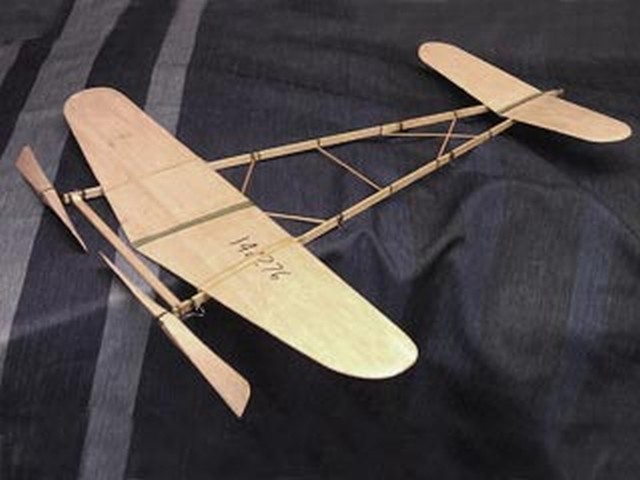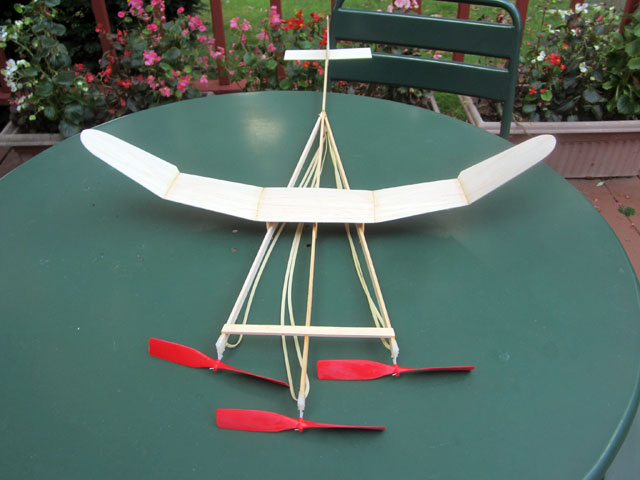ReynoldsSlumber
Well-Known Member
Inspiration
In the days of yore, when reading G. Harry Stine's Handbook of Model Rocketry, an image toward the end of the chapter on staging struck me:
The wheels in my head started spinning and couldn't be stopped.Pat Artis of Ironton, Ohio, perfected parallel-stage model rockets and demonstrated them at NARAM-7 in 1965. By 1966, Artis had refined his designs to carry the booster pads up near the nose of the core model, thereby bringing the CG of the model well forward during the critical boost phase and eliminating the need for large fins to ensure stability during the boost phase. Artis showed that parallel-stage models had superior performance for payload carrying because of their high liftoff acceleration.
Pitchfork
I built an Estes BT-50-based tractor parallel-staged model, stabilized by two T-fins like on Artis's design. It used Estes B6-0s for the boosters and a C6-7 with its longer burn duration for the core. Hooks were attached on either side of the main body tube, and the booster pods each had a pylon with a slot to go onto the corresponding hook (the reverse of a typical boost glider pop pod). Booster motor burnout was to act as the ejection charge to kick each pod off and deploy a streamer. I don't have a photo of the "Pitchfork," as I dubbed it for the obvious reason, but here's a CAD re-creation:



When I went to fly it, my "that looks about right" friction fit on the booster attachment was too loose, so at liftoff things disassembled themselves and flew in two different directions. If memory serves, what happened was that the middle motor lit first and the core took off, while a split second later one of the now-orphaned booster pods cooked off and flew sideways. Lesson learned: forces on a model rocket were stronger than I thought. I also concluded that the igniter lead wires needed to be as long and as lightweight as feasible given the electrical current draw, in order to give the igniters as much of a chance to do their work as possible after the first motor to light started firing. Plus I rediscovered that the boosters' wires should be suspended on stanchions, to relieve their weight and to prevent tangles with the fins.
Flying Pitchfork
Next I built a BT-60-based model, powered by D12-0s and an E15-8, again with streamer recovery on the booster pods. This time it had conventional fins, in order to reduce the risk that a booster streamer would cause a "Red Baron" scenario. Also, given the equivalency to flying on a F motor, getting rid of T-fins reduced the forces on the fin roots as well as the risk of fin flutter. I dubbed it the "Flying Pitchfork" 'cause I meant business this time (or something).

Funny enough, when I went to fly it, it garnered more skepticism from the high power RSO than the low power club folks had given the earlier Pitchfork. Anyways, with a tighter friction fit than before on the pod attachment, and with the aforementioned igniter wire arrangement, it flew great! The boosters' separations appeared to be simultaneous with each other. The booster exhaust heat did cause bubbling of the white paint near the fin roots, so if anyone does a similar model, the effort to make T-fins may be worth it after all. Or at least use paint that can handle higher temperatures.
Further parallel staging thoughts
Early in the Cold War era, Atlas and R-7 ICBMs used parallel staging in order to avoid the difficulties of igniting a second stage mid-flight. For model rockets, is series staging harder than parallel? In the case of core-only black powder motor models with simple tumble recovery on the first stage, series is of course easier. That said, in windy conditions, parallel staging may actually be the better bet, by way of the high initial thrust preventing excessive weathercocking. That goes doubly for tractor parallel staged models, which with their forward CG don't need excessively-sized fins.One more note: staging is allowed in NAR eggloft competition. Has anyone tried to compete using a parallel staged model? Could be advantageous; would be extremely oool.
Cluster F
In thinking about clustered rockets, I hated the thought that a bunch of motors in a side-by-side bundle could cause excessive base drag. I don't know if there's any merit to the idea, but I guessed that by putting some of the motors in tractor pods, it could act as a sort of subsonic version of the "area rule" by spreading base drag out among the aft ends of individual motors. Such a tractor-pusher configuration would form in effect a "minimum diameter" cluster rocket, without the excess cross-sectional area of an enclosing main body tube.What ensued was a BT-20-based balsa nose cone extravaganza. It took a lot of effort to build, most notably when it came to cutting chunks out of nose cones for the front of the pusher section and sanding them to fit snugly against the center tube, in good alignment and with a good seal for ejection pressure. No pop pods here—those tractor booster pods were permanently attached. The model packed a lot of power for its size with three C6-0s up front and three C6-7s in the tail, totaling to a mid-impulse F36, hence the (retroactive) name. In a bold move to minimize drag and weight, motors were friction fit and taped in place, without motor hooks. Again no photo was taken at the time, so here's a CAD representation:




When it came time to launch it, the winds were too strong to go all-out, so I elected to use just the pusher motors. The tractor motors stayed installed, sans ignitors, for proper CG. On ignition, it leapt off the pad and sped upwind, straightening its arc as it accelerated. Pretty darn cool cluster flight.
Though I had tried to reinforce the center body with a BT-5 stuffer tube, when I recovered the model, it was kinked just ahead of the aft section. I never repaired it. I'm guessing that all it would've taken not to bend would've been a thicker-walled tube, better internal reinforcement... and/or perhaps just going for it with all six motors! Although given how straight the flight path was, perhaps the kink happened when it landed under parachute rather than when under power. As with the Flying Pitchfork's fins, there was some scorching on the nose cones at the front of the pusher section.
TetraJet
A drawback of tractor motor models with a full-length core body tube is that, due to the motor exhaust's heat, the tractor pods have their thrust lines spaced away from the CG. So all of the motors had better light, or else a smoke rainbow into the ground is almost assured. How would one instead configure a tractor-pusher rocket on which all of the thrust lines go through the CG?Behold the TetraJet:





Now, this is a concept that I came up with upon reflection on these prior configurations, not a model that I've ever attempted to build. As-designed, it would use 18mm motors: booster motors in the pusher pods, and long-delay motors in the tractor pods. The tractor pods would each house a parachute. If any one motor didn't light, the model would stand a good chance of flying reasonably straight or at least of making it to ejection with sufficient altitude remaining. As shown, the pods are minimum diameter, and the structural connections are 1/4" dowels. The CG would be on centerline a bit ahead of the forward launch lug. The four fin tips sticking out at right angles might not be necessary, although I'd want to have some kind of assurance on stability given the airfoiled forward strut between the two tractor pods. Assembly would no doubt require some fancy jig work, given all the weird angles.
After construction, the other tricky part would be how to handle the igniter wires for the tractor pods, to assure that the igniter clips wouldn't catch on the fins. Perhaps a stanchion up the middle would work, or else one on each side pulling in tension, like umbilicals on a real rocket.
Has anything like this been attempted before? I'm not building and flying rockets currently, but if anyone were serious about bringing such a monstrosity into being, I'd be glad to partner up and supply plans and suggestions.
By the by, there's a lot of potential for fun alternative names for this thing:
Pat Artis's Fever Dream
Robert Goddard's Nightmare
Crossfire Hurricane
I Crossed the Streams
Hot Dog Cookout
Flare
To close out our tractor rocket journey, here's a fun little 13mm motor model called the "Flare." It was an exercise in making a two-finned rocket. In flight it coned into a feverish spiral, so perhaps the fin sweep wasn't doing it any favors. Maybe unswept square fins would do the trick.
Attachments
Last edited:






















